books
psychophysical acting
theatre histories
acting reconsidered



asian martial arts in actors training
when the body becomes all eyes
kathakali dance drama
the kathakali complex
indian theatre
|
Psychophysical Acting: an intercultural approach after Stanislavski
(London: Routledge, forthcoming, September 2008, with DVD-ROM by Peter Hulton)
ISBN-10: 0415334578
ISBN-13: 978-0415334570
Psychophysical Acting is "a powerful tool for those interested in exploring the theory, philosophy, and practice of methods of psychophysical acting. The detailed case studies by themselves should warrant critical attention for the volume from theatre scholars and practitioners alike, and accompanied by both Zarrilli's insights into teaching and practice of psychophysical acting and the supplementary materials provided by the DVD-ROM, the volume as a whole is an immediate, important, and vital addition to discourses on psychophysical theory and practice in performance."
review by Keven McFillen,
Theatre Topics (19, #2, 2009: p. 223).
Psychophysical Acting "...provides a detailed and fascinating insight into the potential benefit of psychophysical training for the contemporary actor...[It will] appeal to a wide range of readers...Each case study provides a detailed and simulating overview of the production and an insight into how Zarrilli implemented his chosen techniques in rehearsal. The introductions to The Beckett Project and 4:48 Psychosis in particular, provide an insightful and intelligent way of contextualizing what is important and difficult about the work of Samuel Beckett and Sarah Kane."
review by Sarah Gorman, New Theatre, Quaterly (25, #3, 2009: p. 296).
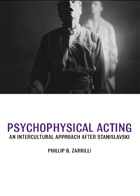
Co-author with Bruce McConachie, Gary Williams, and Carol Fischer Sorgenfrei
Theatre Histories: An Introduction
(London: Routledge, 2006).
ISBN-10: 0415227283
ISBN-13: 978-0415227285
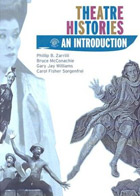
Editor, Acting Reconsidered: Theories and Pratices
(Routledge, 2002 [2nd edition]).
ISBN: 041526300X
“… changes the parameters of what acting is, or is thought to be …”
Seth Baumrin in Theatre Journal.
“… an exciting cross section of contemporary writing about acting … immensely valuable … and a model of critical acumen.”
James Peck in The Drama Review.
“The book’s cohesiveness comes from Zarrilli’s excellent introduction to each section, which not only provides a thematic structure and excites the reader’s curiosity, but also provides valuable commentary on the collected essays. Offering a bridge between the theoretical and the practical, this book is an important contribution to theatre studies.”
Excerpted from review by Gregg Wilson, Backstage, November 8, 1996:32.
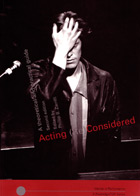
Editor, Asian Martial Arts in Actor Training
(Madison: Center for South Asian Area Studies, 1993)
"The essays collected in this paean to the value of Asian martial arts
training for the Western actor are so convincing that the next generation
of acting teachers should read them immediately."
Diane Daugherty, Asian Theatre Journal, Vol. 13, 1: 135-6.
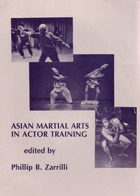 When the Body Becomes All Eyes: Paradigms, Pratices, and Discourses of Power in Kalarippayattu, a South Indian Martial Art
When the Body Becomes All Eyes: Paradigms, Pratices, and Discourses of Power in Kalarippayattu, a South Indian Martial Art
(New Delhi: Oxford University Press, 2000 [paperback edition], originally published, 1998).
ISBN: 0195655389
“One among several recent scholarly works on the arts of Kerala … this book provides a noteworthy discussion of the process of ‘cultivating’ the body in the tradition of Kerala’s martial and medical art known as kalarippayattu. Except Joseph Alter’s work on wrestlers in northern India … this is one of the first major contributions to the study of the martial arts of South Asia … [W]hat sets Zarrilli’s work apart is that it does not merely approach kalarippayattu as a ‘martial art.’ Zarrilli opens up the discursive fields of ritual, medicine, and psycho-spiritual experience around which kalarippayattu situates itself. One of the current motifs in Zarrilli’s work is that of the ‘bodymind’ … Zarrilli’s use of the term moves the focused practice of ‘making the body all eyes’ away from the bifurcation of psyche and physique. By positing kalarippayattu as simultaneously rooted in psychic and corporeal space, Zarrilli’s work redefines the rather reductionist characterizations of kalarippayattu as either ‘martial exercise’ or ‘martial yoga’.
Zarrilli images kalarippayattu through several interpretive ‘paradigms,’ around which the book is organized. The first part relates to histories, ‘real’ and ‘imagined,’ It is an exhaustive study … The following chapter discusses the ritual layout of the kalari…and the transformative processes of construction, inauguration, installation, and daily worship, which actualize the powers of the deities who reside along the outsider perimeter of the space. The next two chapters focus on ‘outer forms’ and ‘inner secrets’. The former takes the reader through the complex physical rigor of the movements and sequences of the kalarippayattu, while the latter is a nuanced discussion of the esoteric Sakta ritual elements involving inner and outer worship … The sixth chapter … is perhaps the first in-depth analysis of the vital spots or junctures … of the subtle body …
Zarrilli’s work also addresses the issue of change and shifting contexts of kalarippayattu from its roots in twelfth-century Nayar communities to its present transnational representation … Chapter 8, dealing with transformations in indigenous practice, is particularly interesting … I see few limitations in this work … [It] is an invaluable contribution to the conscious revisioning of the meanings and implications of the body-in-practice and its multifarious transformations in South Asia.”
Devesh Soneji, McGill University. Journal of Asian Studies, February, 2001:283-4.
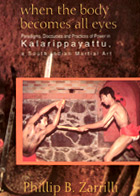 Kathakali Dance-Drama: Where Gods and Demons Come to Play
Kathakali Dance-Drama: Where Gods and Demons Come to Play
(London: Routledge, 2000)
issued along with two videotapes (An Introduction to Kathakali, 25 minutes color videotape; The Killing of Kirmmira - a full-length kathakali play in performance, approximately 4 hours)
ISBN: 041519282X
"... The account combines insights into the actors' performance methods and modes of interpreting texts; translations of four important kathakali plays; and analysis of contested narratives from new kathakali works. To understand kathakali is to penetrate a complexity like that of Wagnerian opera, a repertory akin to Shakespeare, and a language known to few outside of Kerala’s communities. The translations read well … For each play Zarrilli serves as dramaturg, providing commentary that explores heroism, theodicy, and power. A reader will appreciate how episodes from the epic Mahabharata are reduced to playable scenes, and their philosophical subtleties are conveyed. Zarrilli gives voices to Kerala’s performers and writers with well-placed quotes and citations. His own expertise is unquestionable, his involvement extensive and intense. The list of videos available for several plays will make the book even more valuable for those who have never witnessed a kathakali performance.”
Joan L. Erdman, Columbia College, Chicago, USA. Excerpts from Choice, 2000, Vol. 38, #1.
"Kathakali Dance-Drama: Where Gods and Demons Come to Play is a thoroughly well-researched book, tautly written, clinically shorn of all stylistic hyperbole and perfectly produced with notes, references, glossary and so on. Here is a work that is academically sound and yet readable ... [Zarrilli] brings to the study of Indian art all the clinical rigor of a western academic and yet manages to transfer to even the uninvolved reader some of the passion and zeal that he obviously nurtures for Kathakali, its practitioners and its connoisseurs."
Excerpted from review by S. Kalidas, India Today International, April 10, 2000:47).
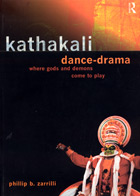 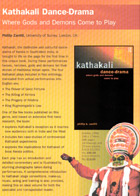 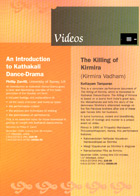 The Kathakali Complex: Actor, Performance, Structure
The Kathakali Complex: Actor, Performance, Structure
(New Delhi: Abhinav Publishers, 1984)
ISBN: 0391030299
“South Asian theatrical traditions have rarely received the detailed analysis and discussion that other forms such as kabuki and noh of Japan, Bejing opera, or the works of major Western genres or dramatists have. Phillip Zarrilli’s book on ‘the Kathakali Complex’ is an ambitious and exemplary attempt to move beyond the limitations of studies currently available in English … [I]t is precisely the general familiarity with kathakali that makes Zarrilli’s book so timely and successful. Zarrilli is not writing an introduction to kathakali; that work has already been done. Rather, his book is an in-depth study of the practices that constitute the kathakali tradition-a close look at its ‘multiple prisms and surfaces’ … Zarrilli writes with the hard-won authority of the participant/observer who has clearly earned the respect and confidence of kathakali teachers and performers through his own immersion in the disciplines involved. He is able to combine this experiential access to knowledge with a usually clear writing style, a sense of scholarly priorities, and a sensitivity to the needs and interests of those concerned with the history, aesthetics, and social implications of kathakali, as well as those with more broadly-based interests in performance theory. This is a hard balance to strike, and I admire his clarity and sense of purpose as he moves among epistemologies-each adding substance and perspective to the other … Zarrilli clearly knows his way through the newly grown but increasingly dense thickets of performance theory. The section offering a ‘micro-analysis’ of a typical kathakali performance ‘strip’ is particularly challenging and intriguing … He … successfully uses structural models to elucidate how the life of the performance is shaped for the actor and the audience in the ‘series of elaborations, elaborations on and within elaborations, and embellishments’ that constitutes the ‘complex performance score of kathakali’.”
Excerpted from “Beyond the Kathakali Mystique” by John Emigh, The Drama Review, 172-175.
“Phillip Zarrilli’s painstakingly meticulous documentation of Kathakali successfully disposes of all the previous erroneous information that has muddled one of the most fantastic theater forms of our day…To our great fortune, Zarrilli is among the growing number of scholars of theater and dance who have forced a new approach to the study of performance…Put forward in layperson’s parlance, Zarrilli’s book is an exquisite explanation of the complex and detailed world of Kathakali from its historical roots…to its diverse contemporary situation in India and abroad…This book is a classic that will hold its place for some time to come.”
Excerpts from review by Carol Martin, Journal of South Asian Studies, 900-901.
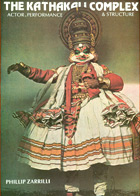
co-author with Farley Richmond and Darius Swann
Indian Theatre: Traditions of Performance
(Honolulu: University of Hawaii Press, 1990).
ISBN: 0824813227
“The editors of Indian Theater intend their work to fill a lacuna in scholarly literature, since there exists no accessible, recent survey of such breadth…”
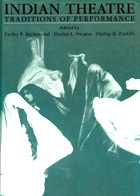
 back to top back to top
|